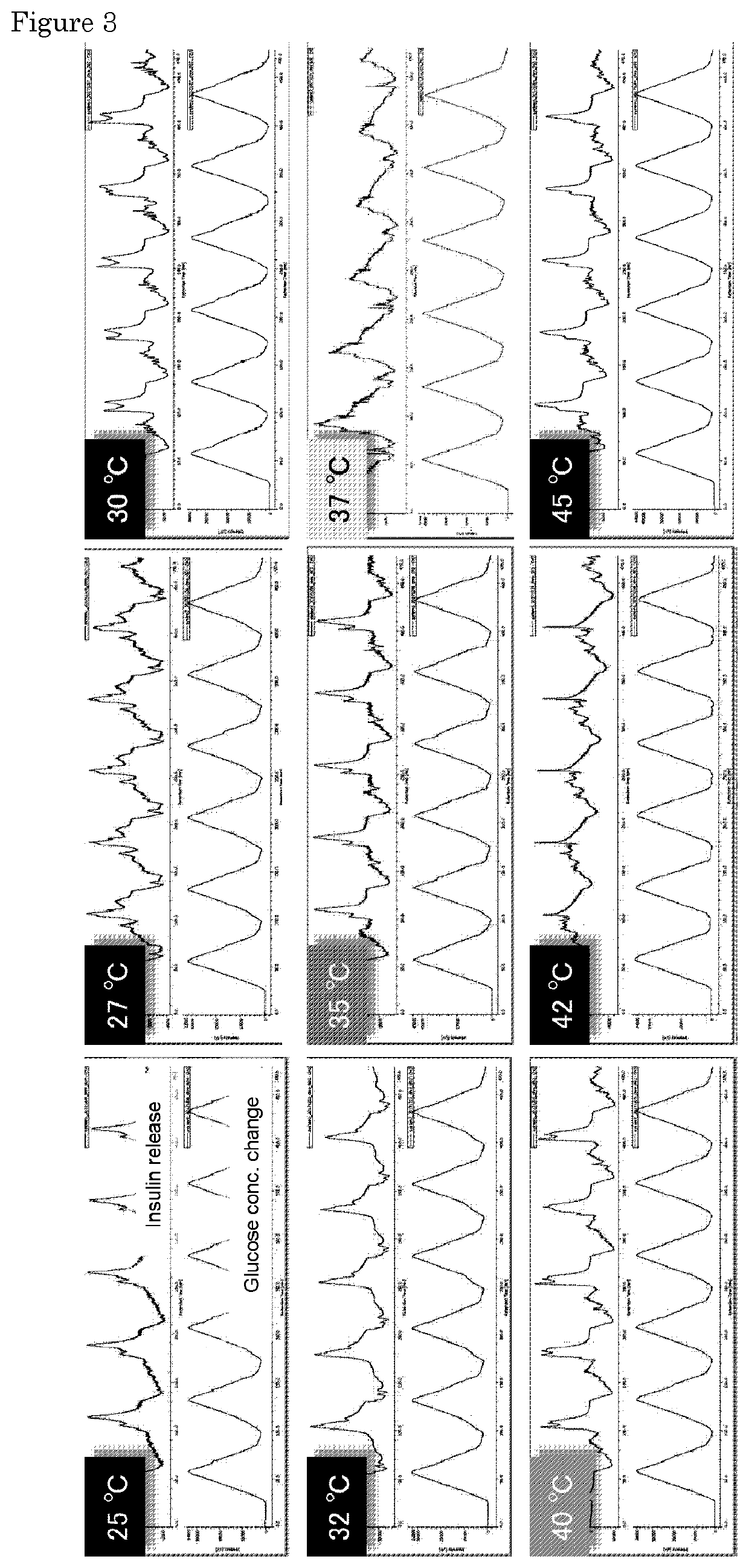Temperature-resistant sugar-responsive gel
- Summary
- Abstract
- Description
- Claims
- Application Information
AI Technical Summary
Benefits of technology
Problems solved by technology
Method used
Image
Examples
example 1
ration
[0070]A gel body of a gel having a columnar shape (diameter in dimethylsulfoxide (DMSO) as a reaction solvent is 1 mm) is produced by blending N-isopropylmethacrylamide (NIPMAAm) as a gelling agent (main chain), 4-(2-acrylamidoethylcarbamoyl)-3-fluorophenylboronic acid (AmECFPBA) as a phenylboronic acid-based monomer, N-hydroxyethylacrylamide (HEAAm) as a hydroxyl monomer, N,N′-methylenebis-(acrylamide) (MBAAm) as a cross-linking agent, and 2,2′-azobisisobutyronitrile as a polymerization initiator in a charged molar ratio of 62 / 27 / 11 / 5 / 0.1 (mol %), and carrying out radical polymerization. Next, the gel body is immersed at 4° C. for 24 hours in a pH 7.4 phosphate buffered aqueous solution (155 mM NaCl) containing FITC (fluorescein isothiocyanate)-modified (bovine-derived) insulin (hereinafter, simply referred to as FITC-modified insulin) at a concentration of 0.5 mg / 1 mL to diffuse the FITC-modified insulin into the gel body.
[0071]The gel body is then removed from the phosphate...
example 2
of the Temperature Sensitivity of Gels
[0074]Fifteen types of samples a to o have various blending ratios (mol %) of N-isopropylmethacrylamide (NIPMAAm), 4-(2-acrylamidoethylcarbamoyl)-3-fluorophenylboronic acid (AmECFPBA) and N-hydroxyethylacrylamide (HEAAm) were prepared by the same procedure as in Example 1. Here, the gel sample a was prepared by mixing N-isopropylmethacrylicamide (NIPMAAm) and 4-(2-acrylamidoethylcarbamoyl)-3-fluorophenylboronic acid (AmECFPBA) prepared at a blending ratio of 90:10 (mol %), and adding N-hydroxyethylacrylamide (HEAAm) to the mixture at a volume ratio of 90:10 (final molar ratio: 81 / 9 / 10). Similarly, the gel sample b was prepared by mixing N-isopropylmethacrylicamide (NIPMAAm) and 4-(2-acrylamidoethylcarbamoyl)-3-fluorophenylboronic acid (AmECFPBA) prepared at a blending ratio of 90:10 (mol %), and adding N-hydroxyethylacrylamide (HEAAm) to the mixture at a volume ratio of 80:20 (final molar ratio: 85 / 10 / 5). Other gel samples also contain these thr...
example 4
ehavior of Temperature-Resistant Gels
[0076]One hollow fiber used in the polysulfone dialyzer (APS-15SA4537693003682) manufactured by Asahi Medeikaru Corp. was used as the device (internal diameter 185 μm, thickness 45 μm). In this example, a commercially available silicon catheter for insulin (4 Fr: inner diameter of about 600 μm, Prime Tech Co., Ltd.) was connected to the device to function as a reservoir for supplying insulin.
[0077]The insulin release experiment was performed using two pumps, and a high performance liquid chromatography (HPLC) system with an internal detector for refractive index (RI), UV and fluorescence intensity (JASCO, Japan).
[0078]By immersing the gel prepared in the same manner as in Example 1 in PBS containing 130 mg / L of the FITC-labeled bovine insulin (WAKO, Japan) at 4° C. for 24 hours, the FITC-labeled insulin was encapsulated in the gel. The gel was then filled into the device of the present invention and the device was quickly placed in a 0.01 M HCl a...
PUM
| Property | Measurement | Unit |
|---|---|---|
| Temperature | aaaaa | aaaaa |
| Electrical resistance | aaaaa | aaaaa |
| Responsivity | aaaaa | aaaaa |
Abstract
Description
Claims
Application Information
 Login to View More
Login to View More - R&D
- Intellectual Property
- Life Sciences
- Materials
- Tech Scout
- Unparalleled Data Quality
- Higher Quality Content
- 60% Fewer Hallucinations
Browse by: Latest US Patents, China's latest patents, Technical Efficacy Thesaurus, Application Domain, Technology Topic, Popular Technical Reports.
© 2025 PatSnap. All rights reserved.Legal|Privacy policy|Modern Slavery Act Transparency Statement|Sitemap|About US| Contact US: help@patsnap.com



